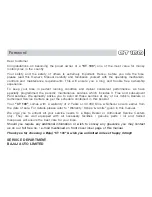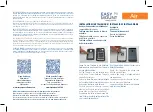
22
N70-2 GT
rials might occur. These contaminations will cause marks and stains to develop.
In these cases (e.g. when the helmet is kept in the top case on hot days), it is
recommended to make sure the VPS is not touching other materials.
3
DISASSEMBLING THE VPS
3.1 Open the helmet visor and lower the VPS completely (see instructions above).
3.2 Hold the left side part of the sunscreen and pull it toward the outside of the helmet
(Fig. 16).
3.3 Repeat the same operation on the right side of the helmet.
4
ASSEMBLING THE VPS
4.1 Open the helmet visor completely and move the side slider up to the end-stop (see
instructions above) (Fig.14).
4.2 Insert the left end of the sunscreen into the left side guide until it is engaged in the
seat of the shell (Fig.16).
4.3 Repeat the same operation on the right side of the helmet.
WARNING
-
Make sure the VPS operates correctly by activating and deactivating the side
slider (see instructions above).
If necessary, repeat the above-mentioned operations.
-
If the VPS opening and closing mechanisms are not working properly or if such
mechanisms get damaged, please contact a Nolangroup authorized dealer.
-
Do not use the helmet if the VPS has not been assembled properly.
-
Since the VPS does not assure you the same protection as the one provided by
the visor, it has to be used only when the helmet visor is lowered.
REMOVABLE INNER COMFORT PADDING
1
DISASSEMBLING THE INNER COMFORT PADDING
To disassemble the inner comfort padding, lift the VPS, open the visor completely and
remove the chin guard from the helmet (see instructions above).
1.1 Open the chin strap (see speci
fi
c instructions), remove the left front roll neck
fl
ap
from the cheek pad; pull the front part of the left cheek pad towards the inside of
the helmet to release the snap fastener located on the left frame (Fig.17). Repeat
the same operation on the right side of the helmet.
1.2 Release the roll neck left eyelet from the left frame (Fig.18). Repeat the same op-
eration on the right side of the helmet.
1.3 Release the left rear
fl
ap of the liner from the shell edge by slightly puling the com-
fort padding towards the inside of the helmet (Fig.19). Then repeat the operation
with the central
fl
aps and with the right
fl
ap too.
1.4 Hold the left front part of the liner and pull it upwards in order to remove the cor-
responding liner
fl
ap from the support
fi
xed to the polystyrene inner shell (Fig.20).
Then repeat the operation with the central front
fl
ap and with right
fl
ap.
1.5 Remove left and right side
fl
aps of the comfort padding from the cavities between
the inner polystyrene cheek pads and the outer shell (Fig.21).
1.6 Remove the chin straps from the liner (Fig.22).
1.7 Completely remove the liner from the helmet.
At any time, without operating the visor, the VPS can be deactivated with a simple
movement and easily lifted up to restore the normal conditions of visibility and protec-
tion guaranteed by the approved helmet visor.
1.1 To activate the VPS, move the slider as in Fig.14 until you hear a click con
fi
rming
that the VPS is in the desired position.
The VPS is adjustable in a range of intermediate positions to ensure the best
comfort for the user with respect to the terms of use.
1.2 To deactivate the VPS, press the recovery button as shown in Fig.15 until the VPS
unlocks and moves automatically to standby position.
2
PRECAUTIONS FOR USE OF VPS
The current approval standards (ECE22-05) state that the visor minimum light transmit-
tance levels must be greater than 80% when riding at night and not less than 50% when
riding during the day. For this reason, under particularly bright weather conditions, e.g.
very strong sunlight caused by high intensity and/or incidence of the sunbeams, the
use of sunglasses - which entail a transmittance much lower than 50% - turns out to
be advisable, if not absolutely necessary. This in order to reduce eye fatigue on long
trips. Sunglasses also reduce the risk of direct dazzling as opposed to the use of mere
approved helmet visors. However, the use of sunglasses makes it dif
fi
cult to perform
emergency manoeuvres when the maximum visibility range of the helmet visor must be
quickly restored. Just think, for example, of what happens when you enter a tunnel or
when unexpected changes in environmental brightness occur. Thanks to its operating
mechanism, the VPS makes these operations much easier.
WARNING
-
Use the special slider to activate/deactivate the VPS; do not deactivate the VPS
by handling it directly.
-
The VPS can only be used during the day and under the environmental conditions
described before.
-
At night and/or in conditions of poor visibility, the VPS must be deactivated.
-
Always ensure that the VPS is properly positioned according to different weather/
environmental conditions and/or the recommendations for use outlined above.
-
We recommend using the VPS only and solely together with the approved stand-
ard visor, which has a transmittance value greater than 80%.
-
The VPS does not replace the protection guaranteed by the visor.
-
Always make sure that the VPS is clean and that it is operating properly in order to
avoid scratches and/or anomalous wear on it every time it is activated.
-
As for VPS and visor maintenance and cleaning operations, please refer to the
appropriate section in the helmet user’s manual.
-
The VPS scratch resistant/fog-resistant treatment highly reduces fogging. Pro-
tracted periods of adverse weather and/or environmental conditions might cause
fogging and/or formation of condensation on the VPS, which entails a reduction of
visibility and/or sharpness of vision: in this case, deactivate the VPS.
-
In case of rain, the direct contact of raindrops with the scratch resistant/fog-resist-
ant treated VPS quickly reduces sharpness of vision, thus causing scarce visibility:
in this case, deactivate the VPS.
-
The special VPS fog-resistant treatment is usually sensitive to high temperatures
or heat sources. In this case, contaminations caused by contact with other mate-
INSTRUCTIONS FOR USE
Содержание N70-2 GT
Страница 15: ...15 N70 2 GT ISTRUZIONI D USO...
Страница 29: ...29 N70 2 GT INSTRUCTIONS FOR USE...
Страница 113: ...113 N70 2 GT VEJLEDNING...
Страница 114: ...114 N70 2 GT design 1 1 1 1 2 1 3...
Страница 115: ...115 N70 2 GT 2 2 1 2 2 3 3 1 3 2 3 3 EL A...
Страница 116: ...116 N70 2 GT N70 2 GT 1 1 1 1 1 2 2 jet 3 R L 2 2 1 2 2 3 2 3 4 2 4...
Страница 123: ...123 N70 2 GT 2 4 20 VPS 1 4 2 4 2 5 19 2 6 18 2 7 17 3 VPS 3 1 17 3 2 18 3 3 19 3 4 23 3 5 19 21 1 5 2 3 3 6 17 4 4 1 17...
Страница 125: ...125 N70 2 GT 5 2 25 5 3 VPS N70 2 GT 1 1 1 1 2 L 26 1 3 27 1 4 R 2 2 1 27 2 2 Nolangroup Small XXS M Large L XXXL...
Страница 128: ...128 N70 2 GT FIG ABB EIK KUVA 1...
Страница 129: ...129 N70 2 GT FIG ABB EIK KUVA 2 4 3 5 7 6 9 8...
Страница 130: ...130 N70 2 GT FIG ABB EIK KUVA 10 12 11 13 15 14 17 16 A B MIN MAX...
Страница 131: ...131 N70 2 GT FIG ABB EIK KUVA 18 20 19 21 23 22 25 24...
Страница 132: ...132 N70 2 GT 26 28 27 30 29 31 FIG ABB EIK KUVA...
Страница 133: ...133 N70 2 GT 33 34 32 FIG ABB EIK KUVA...
Страница 134: ...134 N70 2 GT Note Clipboard Notizen Notas...
Страница 135: ......















































